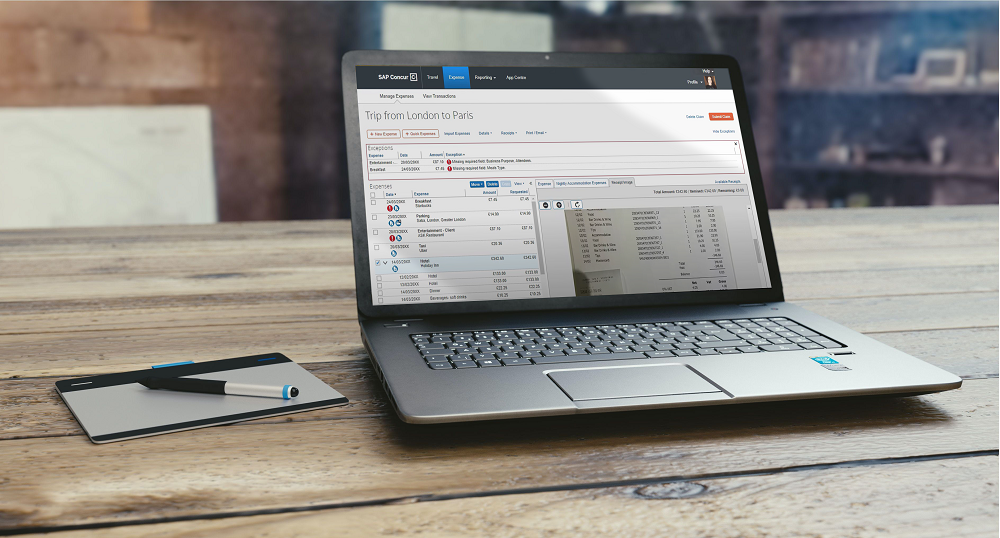SAP Concur is a cloud-based software application that helps organizations manage expenses. It offers features for booking travel, tracking expenses, and generating reports.
Concur can be used to track expenses incurred by employees while on business trips, as well as to manage corporate credit card spending. The software can also be used to generate reports on employee spending, which can help businesses identify areas where spending can be reduced.
How to use it?
To use SAP Concur, businesses first need to create an account and then add employees. Once employees are added, they can begin entering their expenses into the system. SAP Concur offers a mobile app for easy expense tracking on the go.
When it comes time to submit expenses for reimbursement or payment, SAP Concur makes it easy to do so. Simply select the relevant expenses and submit them for approval. The system will route the request to the appropriate manager or approver for review and approval.
It can also be used to book travel. Enter your travel dates and destination and the system will search for flights, hotels, and rental cars that fit your needs. You can then book your travel directly through SAP Concur.
Overall, this is a helpful tool for businesses of all sizes to manage their expenses and travel plans. It offers a simple way to track spending and get insights into where money is being spent.
Pros and Cons of SAP Concur

When it comes to choosing expense management software for your business, there are a lot of options out there. SAP Concur is one of the most popular options, but it’s not without its drawbacks.
PROS:
- Easy-to-use interface: One of the biggest advantages of using SAP Concur is that it has a very user-friendly interface. This makes it easy for employees to submit expenses and for managers to approve them.
- Automates expense reporting: SAP Concur can save your business a lot of time by automating the expense reporting process. It can automatically generate reports based on submitted expenses, which can help streamline your accounting and finance processes.
- Integrates with other software: Another big advantage of using SAP Concur is that it integrates with other software, such as accounting software like QuickBooks or travel booking software like Kayak. This makes it easy to keep all your business travel information in one place and makes expense management much simpler.
CONS:
- High cost: One of the biggest drawbacks of using SAP Concur is that it can be quite expensive, especially for smaller businesses. The cost may be worth it if you think your business will benefit from all the features this program offers, but it’s something to keep in mind.
- Complicated setup: Another drawback is that it can be quite complicated to set up. If you’re not familiar with the software, it may take some time to get everything configured correctly.
- Limited customer support: One final downside of using SAP Concur is that customer support can be quite limited. If you run into any problems with the software, you may have to wait a while for someone to help you resolve the issue.
The Best Alternatives

There are many alternatives to SAP Concur like blog.happay.com, each with its own set of pros and cons. Some of the most popular alternatives include:
- Expensebot: This expense-tracking software is designed specifically for small businesses and startups. It is simple to use and offers a free trial period.
- Zoho Expense: This expense management software is part of the comprehensive Zoho suite of business tools. It is feature-rich and offers a free plan for small businesses.
- FreshBooks: This accounting software includes robust expense-tracking features. It has a free plan for very small businesses and a 30-day free trial for larger businesses.
- Wave Accounting: Wave is popular accounting software that offers a free plan for very small businesses. It includes basic expense tracking features and integrations with popular payment processors such as PayPal.
- Xero: Xero is another popular accounting software that offers a range of plans, including a free plan for very small businesses. It has advanced expense tracking features and allows users to track expenses by project or client.
How to Choose the Right Travel Management System for Your Business

As businesses increasingly look to adopt cloud-based solutions, many are turning to travel management systems (TMS) to help streamline their operations. TMS software helps businesses manage the end-to-end process of corporate travel, from booking and itinerary management to expense reporting and compliance.
While there are many TMS solutions on the market, not all are created equal. When choosing a TMS for your business, it’s important to consider your specific needs and requirements. To help you make the best decision for your business, we’ve put together a list of things to keep in mind:
- Ease of use: A good TMS should be easy to use and intuitive. It should allow users to quickly book travel and track expenses with minimal training.
- Robust features: Look for a TMS with robust features that can grow with your business. Important features to consider include itinerary management, online booking tools, expense reporting, and compliance tools.
- Integration capabilities: A good TMS should be able to integrate with other business applications, such as your accounting or CRM software. This will help improve efficiency and avoid data silos.
- Flexibility: Your business’s needs may change over time, so it’s important to choose a TMS that is flexible and can accommodate future growth.
5 . Customer support: When something goes wrong with your TMS, you’ll want to be able to reach customer support quickly. Look for a vendor with a responsive customer support team that can help resolve issues in a timely manner.
Conclusion
If you’re looking for a comprehensive expense management solution, SAP Concur is definitely worth considering. However, it’s important to weigh the pros and cons before making a decision – and to also explore some of the best alternatives out there. We hope this article has helped you do just that.







